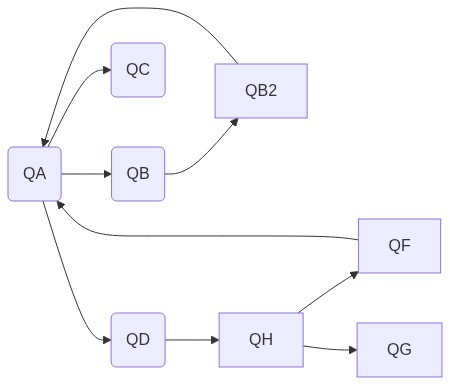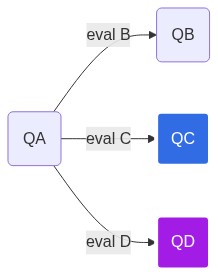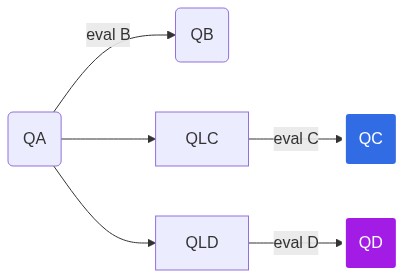Exchanges
keuss-server provides the ability to define a graph interconnecting queues with consumer loops, where:
- each consumer loop read from exactly one
srcqueue - each consumer loop pushes in sequence to zero or more
dstqueues - each push into a
dstqueue is controlled by a selector function: it controls whether the push is to be done or not, and also can modify the message
Therefore, an exchange is comprised of a src queue, a consumer loop, and set of dst queues with their selectors.
Zero or more exchanges can be defined either by configuration or by REST API (although in the latter case they are not persisted yet);
exchanges can use any queue in any namespace defined to keuss-server; so, exchanges can create a mesh or graph interconnecting queues on various locations, using different backend, stats and signal technologies
Exchange spec
A more formal js-like spec would be:
{
consumer: {
parallel: <int, optional, defaults to 1>
wsize: <int, optional, defaults to 1>
reserve: <bool, optional, defaults to false>
},
src: {
ns: <string>
queue: <string>
},
dst: [
{
ns: <string>
queue: <string>
selector: <optional, string|function, no default>
}[0..n]
]
}
consumerparallel: how many loops in parallel an exchange runs, one by defaultwsize: maximum number of in-flight elements (ie, popped but not yet pushed/committed) allowed among all loopsreserve: if true, usesreserveto get elements fromsrcand thencommitafter all pushes have been done (orrollbackif an error arose); if false, usespopto get elements
srcns: namespace of the source queuequeue: name of the source queue; if non-existent it will be created
dst: array of zero or more destination queues, each of them with the following values:ns: namespace of the destination queuequeue: name of the destination queue; if non-existent it will be createdselector: function to define whether a popped element is pushed into this destination queue (more information below)
Loop execution
Here is a pseudocode (simplified) definition of the exchange loop:
forever
if reserve
elem = reserve_elem_from_src_queue
else
elem = pop_elem_from_src_queue
if too_many_hops(elem)
push_elem_to_toomanyhopsqueue
continue
for each dst
eval = dst.selector(elem)
if eval
push_elem_in_dst
if error break
if error_in_dst_loop
if reserve
rollback_elem_in_src_queue
else if elem_not_pushed_anywhere
push_elem_to_noroutequeue
As noted before, one instance of this loop (or more precisely, as many as consumer.parallel) will run per exchange, per server in the cluster
The selector
There is an optiona selector function per destination; it can take the following values:
- null, not defined: it will take the semantics of 'pass': the message will always be pushed to the destination
- a js function with the prototype
fn(env) -> ret - a string parseable with node.js
vmmodule into a js function with the prototypefn(env) -> ret
The selector gets called with one env object parameter that will contain 2 keys:
msg: the message being looped. The selector recevies the actual message, not a copy, so it can modify the message in mid-loopstate: an object to keep state along each cycle of the loop: it is set to{}after each message is popped, and it's just kept and passed to all destinations' selectors in sequence. Selectors have no limitations about what can be done with the state
The selector is then expected to return a single value:
- a truthy value will indicate the message gets pushed to the destination
- if the return value is a non-empty object, 3 optional keys are taken into consideration to modify how the message is
pushed:
mature: specifies a mature time for the push() keuss opertiondelay: specifies a delay for the push() keuss opertiontries: specifies a number-of-tries for the push() keuss opertion
- if the return value is a non-empty object, 3 optional keys are taken into consideration to modify how the message is
pushed:
- a falsey values will indicate the message does not get pushed to the destination
Examples
Defining a selector function like:
exchanges: {
x1: {
src: {...}
dst: [{
{
ns: 'ns1',
queue: 'one_dest',
selector: env => {return {delay: 1}},
},
...
}]
}
}
will mean that any message arriving to the exchange's src queue will be pushed to the destination queue, and will be
done so with a delay of 1 second, as specified by the delay return parameter
This could be also written as a string, which would be json-compatible:
exchanges: {
x1: {
src: {...}
dst: [{
{
ns: 'ns1',
queue: 'one_dest',
selector: 'env => {return {delay: 1}}',
},
...
}]
}
}
A more complete example, where the selector actually checks some of the message's headers:
exchanges: {
x1: {
src: {...}
dst: [{
{
ns: 'ns1',
queue: 'one_dest',
selector: env => (env.msg.hdrs['aaa'] && env.msg.hdrs['aaa'].match (/^yes-/)),
},
...
}]
}
}
messages into the exchange's src will be copied into queue ns1.one_dest if there is a header named aaa, whose value starts with yes-
A note on loops on the exchange graph
As already mentioned, it is possible to create graphs of any shape with exchanges; this means that infinite loops may appear, if the selector functions involved do not take this into consideration
To add a safeguard against infinite loops, an additional main.max_hops config parameter may be set as a limit for the maximum number of hops that a message may perform to avoid saturating the queues.
For example, giving this configuration:
Messages flowing from QA may return to the source due to the exchanges from QB2 and QF, so processing a set of messages in QA may cause an exponential growth of the number of messages in the same queue.
Exchange Stats
Exchange execution will also report statistics about the queues execution and evaluation times
Use case: Distributed Exchanges (queues on different servers)
Source and destination queues may be on different namespaces/BBDD (which means that some destination endpoint may be unreachable due to network or temporal issues). In that case, since the exchange is synchronous and not transactional, you may end up with problems due to duplicate messages arriving to queues on the same server of the source queue, or missing messages that fails to reach remote queue servers. Lets see an example:
In this schema, both QC and QD are queues defined in different servers, so, when a message arrives to QA, the exchange may propagate it to QB (which is in the same server), QC (in a remote server) and QD (in a different remote server), depending on the result of their selector function.
Since the exchange is synchronous, once a message is pulled from the source and committed into the first target, it will not be rolled back if the rest of the nodes fail to push it also, so, if QC and QD are having temporal issues, the message may be lost for them.
We can try to change selector functions to take this into account and re-insert the message into the source queue, but doing so may cause the message to be duplicated for QB, unless we start adding changes in our selector code to add meaningful state info to the message before inserting it back in the source code. This may end up adding a big over-complexity in the selector functions, which is not desirable at all. Instead, we can have a much-simpler way of dealing with this kind of configuration by adding some intermediate queues:
QLC and QLD here are queues in the same server as QA, and merely act as a temporal stage before trying to exchange with the remote servers QC and QD. This way, the exchange is not blocked in case the remote servers presents any temporal issue.


